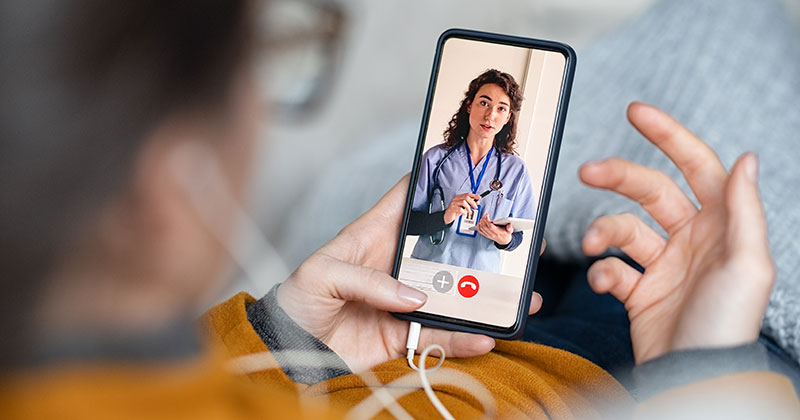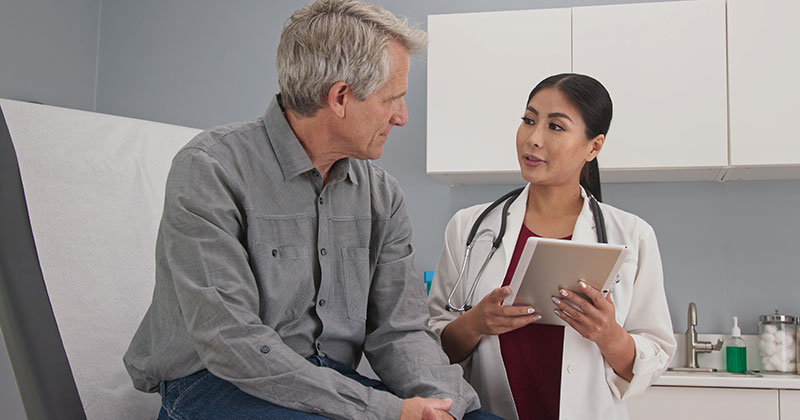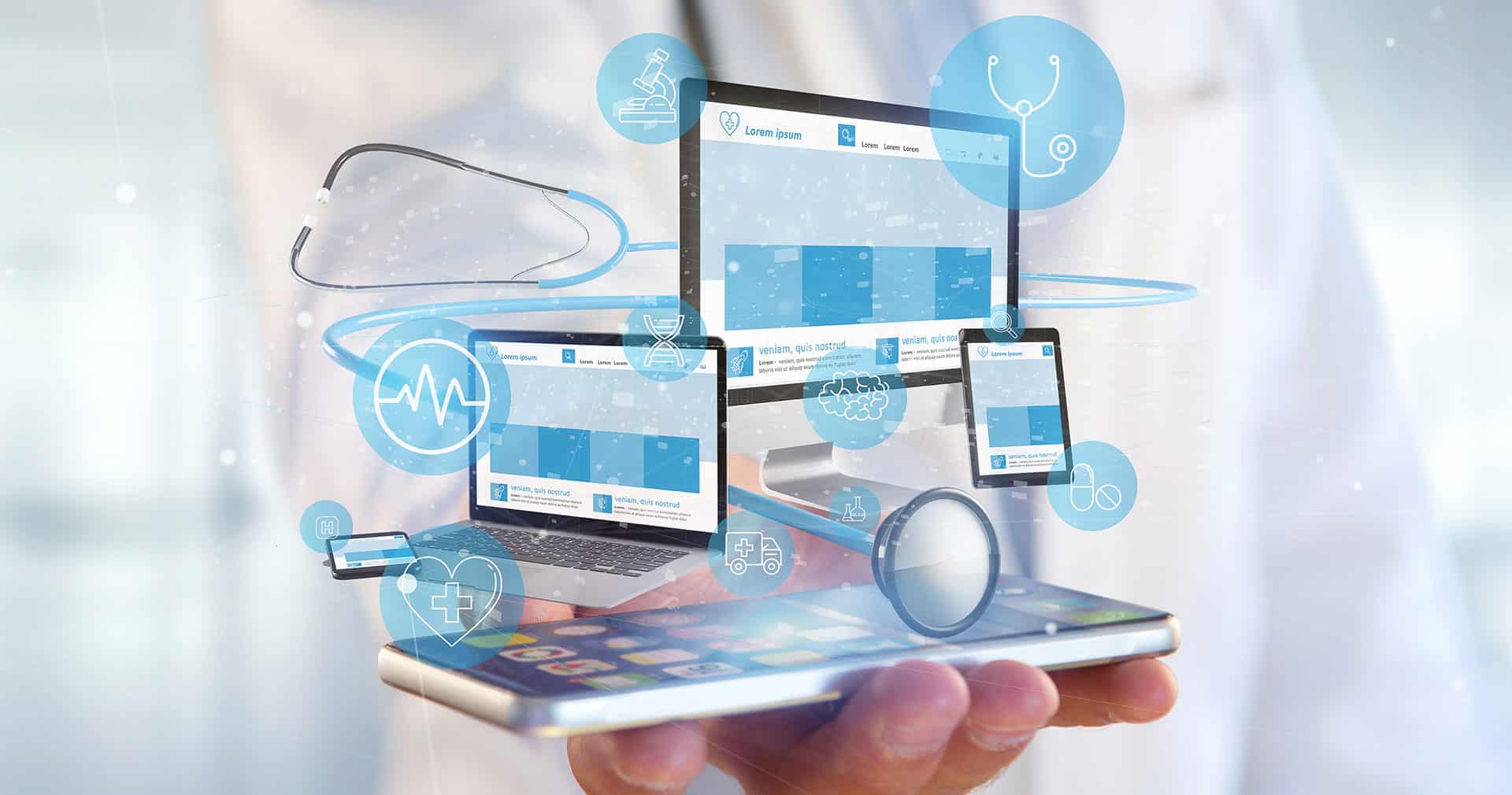Patients’ perceptions of telehealth vs. in-person visits have changed in recent years. In 2021 and 2022, 22% of patients used telehealth at least once, and 80% of doctors plan to continue offering video appointments.
While the pandemic provided the perfect proving ground for telehealth, it remains perfectly suited to some services. Medical clinic managers and staff should be prepared to embrace this trend.
For example, providers can assess patients with minor illnesses or injuries or provide follow-up appointments. They can also provide mental health services using video calls.
Of course, it does have its limits. Any labs, physical tests, or imaging would still require in-person appointments.
Providers should know how to examine patients properly via video. They must also learn how to question patients to accurately assess their condition without their physical presence.
Providers need to know when it’s appropriate to offer telehealth and when it’s necessary to bring patients into the clinic.
Practice managers must also be thoroughly educated on the tech aspect of telehealth to streamline administrative duties and maintain patient security.
According to EverHealth, “When selecting a platform and software, practices need to ensure patients and providers can use it confidently. The telehealth platform needs to protect patient privacy and follow HIPAA security standards.”
In this article, we’ll learn when telehealth visits are the most beneficial. Then, we will discuss different use cases and the features to consider when choosing a telehealth platform.
What Are the Benefits of Telehealth vs. In-Person Visits?
Telehealth visits aren’t limited to a computer screen. Providers and patients can also interact through a smart device or a simple voice call.
By combining communication technologies and advanced medical monitoring technologies, providers can stretch the bounds of telehealth even further. Blood pressure, heart rate, glucose levels, and other physiological data can be collected remotely through wearable sensors and transmitted directly to providers.
During in-person visits, of course, providers collect this data themselves and send patients to separate locations for lab tests or imaging.
Each option has its own set of drawbacks and advantages. Let’s take a closer look at the pros and cons of each.

The Pros and Cons of Telehealth
Before determining when it’s best to offer the telehealth option, it’s best to understand where they succeed and where they stumble.
Here are some advantages telehealth offers:
Increased Access
Anyone with an internet or phone connection can access healthcare from the safety and comfort of their homes. Remote access is especially beneficial for the elderly and those in rural areas. It helps prevent the difficulty of arranging unnecessary trips to a clinic.
Decreased Wait Time
If providers are able to offer preferred telehealth for minor medical concerns, it can expedite patient care. This can be especially helpful in decreasing the appointment load and, thus, wait times at busy practices.
Patient Engagement
Patients can request support or follow-up when and where they need it. They can use telehealth to request healthcare information, self-care options, and care for family members.
Cost Savings
Providers aren’t confined to their practice 100% of the time. That cuts costs for staff and clinic upkeep.
It reduces patients’ expenditure in transportation costs to get to a clinic.
The disadvantages of telehealth include:
Technological Challenges
Some patients may not have access to a computer or device for the telehealth platform. Or their device may not have video capability. These patients may still face challenges accessing care.
Limited Capability
Providers can see patients on a webcam and ask questions. But in-depth physiological exams will still have to be handled in person. Complex medical diagnoses will also be better suited to in-person visits.
No Lab Tests or Imaging
The patient will still have to come into the clinic for lab tests, imaging or to have a nurse read vital signs.
Sometimes, necessary services outweigh these negatives, especially if many of your patients face access challenges.
Pros and Cons of In-Person Visits
When looking at the pros and cons of telehealth, it’s important to remember that in-person visits have pros and cons as well.
The following are the advantages of in-person visits:
Full Medical Exams
The provider can examine the patient completely during an in-person visit. Physical exams can be more thorough, especially in cases of internal signs of illness or injury.
Immediate Diagnostics
The doctor can order tests or images at the time of the appointment if needed. A more complete picture can help speed up diagnosis.
Quick Treatment
The medical staff can start treatment immediately. For example, they can offer treatment to relieve pain and reduce symptoms.
The drawbacks of in-person care include:
Wait Times
There can often be extended wait times for scheduling. Additionally, once patients make appointments, they also wait at the clinic for providers to see them.
Disease Transmission
If the patient is sick, they expose other patients and staff to transmission during their visit. This problem was common during the COVID-19 pandemic.
Resource Depletion
Patients with minor medical issues deplete resources and time during in-person visits that would be better utilized for people with more urgent conditions.
Practice managers and staff need to weigh individual patient needs. Then, they can decide where to allocate their in-person capabilities.
RELATED ARTICLE: The Future of Telehealth: Predictions and Trends for the Next Decade

When to Offer Telehealth vs. In-Person Healthcare Visits
In medical practices, providers need to decide when it’s appropriate to suggest telehealth over in-person visits. Decisions should always be considered on a case-by-case basis. The practice should have guidelines available for staff to help determine the proper appointment type.
Here are seven instances when telehealth is an appropriate option:
Condition Management and Follow-Ups
Telehealth is an efficient option for follow-ups and managing chronic medical conditions. Providers do not need to make diagnoses or do in-depth physical exams. They only need to check up on patients.
This type of care would take up time for both staff and patients in an in-person clinic. Both can save time with remote care. Meanwhile, patients remain engaged with doctors and involved in their medical care.
Minor Illnesses
Sometimes, patients want treatment for minor injuries or illnesses. A common cold, migraine, arthritis pain, or flu may fall into this category. In these cases, providers can offer advice or write prescriptions.
Or determine if symptoms could signal a serious illness and warrant an in-person visit. The doctor should always advise the patient to make an in-person appointment if symptoms don’t improve.
RELATED ARTICLE: How Medical Practices Can Increase Efficiency with Time-Saving Healthcare Technology
Emergency Triage
Telehealth vs. in-person healthcare visits is not an all-or-nothing choice. You can combine them for optimal patient outcomes.
Emergency triage is one of those cases.
Emergency care providers can ask targeted questions about symptoms and view patients on a webcam. They can determine the seriousness of the injury or illness.
If it’s deemed serious enough, they can tell the patient to go to urgent care or an emergency room. If it’s not as serious, the patient can wait for an appointment with their primary care provider.
Mental Health
Mental health services do not usually include physical exams or diagnostic tests. Counselors and psychologists rely on talking with patients for diagnosis and treatment.
Of course, there are exceptions to this rule. But many therapy sessions have the same content, whether in person or virtual.
Specialized Care
A clinic can offer access to specialists anywhere in their network via telehealth platforms. These specialists can help manage specific conditions or offer a second opinion.
For example, a nutritionist might use a telehealth platform to help diabetic patients improve their diet. These other services would be low-cost and convenient for everyone.
Patient Monitoring
As previously mentioned, healthcare practices can use remote monitoring technologies to offer care. These medical technologies could provide data on respiration, heart rate and blood pressure, glucose and oxygen levels, and other physiological conditions in real time.
These readings allow doctors to monitor patients consistently. They are aware if the condition improves or worsens. They can reassess diagnoses or make treatment changes based on this info.
Wellness Visits
Preventative medicine services are often a good fit for telehealth. Providers can engage with patients via telehealth and give medical advice over a video call, as well as health education and provide resources for self-care.
Studies have found wellness visits effective. One study said there was a 5.7% decrease in health costs in patients who had an annual wellness visit. Telehealth is a convenient option for these services.
Patients can use asynchronous communication like chat or messaging to ask doctors questions. Doctors can respond when it’s convenient.
RELATED ARTICLE: The Role of Mobile Apps in Healthcare Patient Engagement
How You Can Join the Telehealth Movement
Telehealth can be a viable pathway to improved patient care in your practice, but it needs a proper setup. Here are five crucial steps as you join the telehealth movement:
Research Telehealth Platforms.
Investigate available telehealth options to find the platform accessible to the largest group of patients. You may prefer options that don’t need high-quality software or expensive devices. Also, look at reviews to ensure ease of use.
Learn About Regulations.
Whichever platform you choose, your telehealth platform must adhere to privacy laws, including HIPAA. Understand the type of security and encryption you need to meet these requirements.
Talk to Staff About Telehealth.
Communicate with all providers and staff advising how to use the telehealth platform. Consistent communication helps them determine which services to offer. For example, you can provide triage if you have staff with experience in this area.
Consider Current Needs.
Patient load, services, location, and hours should all factor into your decision-making. Your goal should be to use telehealth technologies to meet patient needs.
Get Patients’ Opinions.
Patients need to trust that the quality of telehealth services meets the same standard of care they receive in-office. Request their opinions. This input can also give you an idea of what patients don’t understand about telehealth so that you can better educate them.





